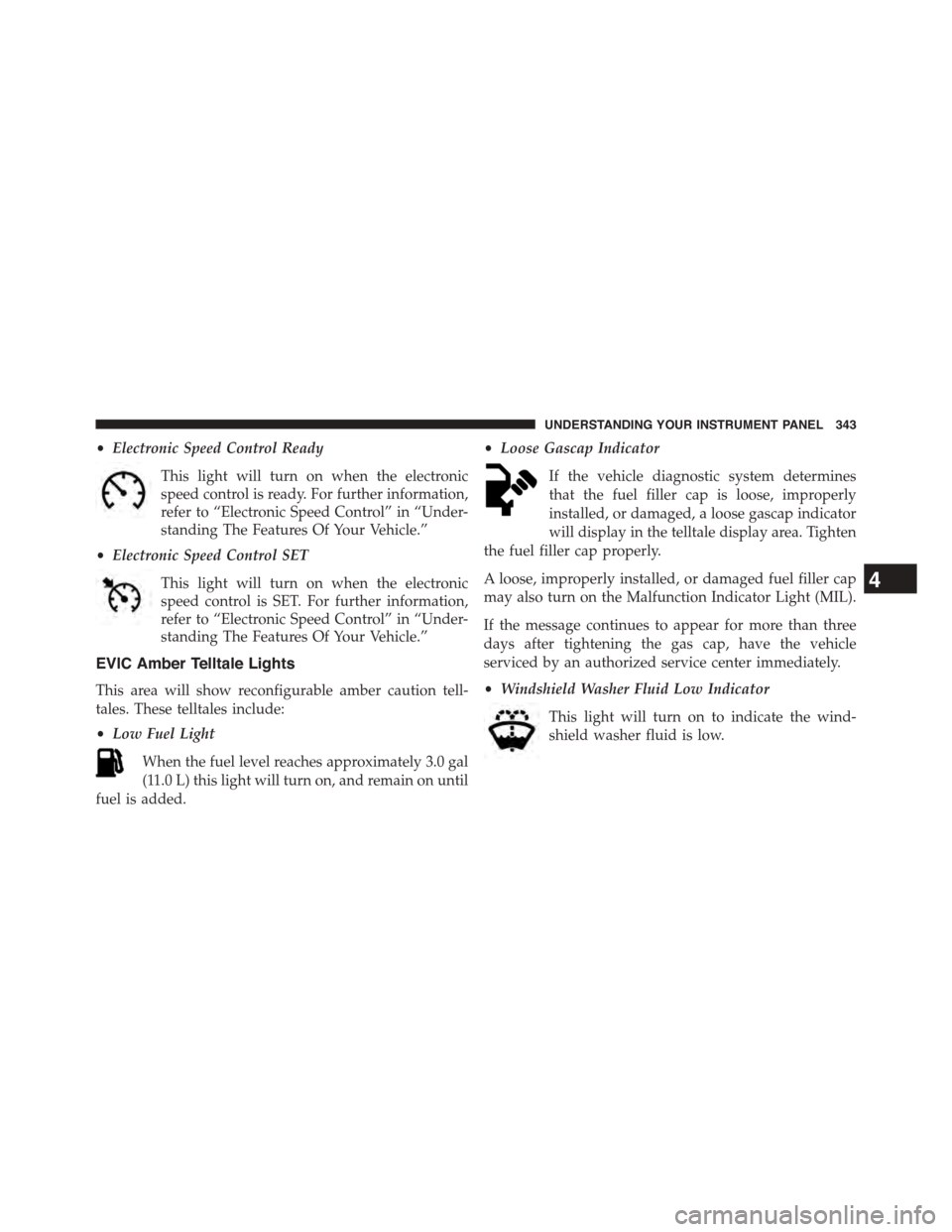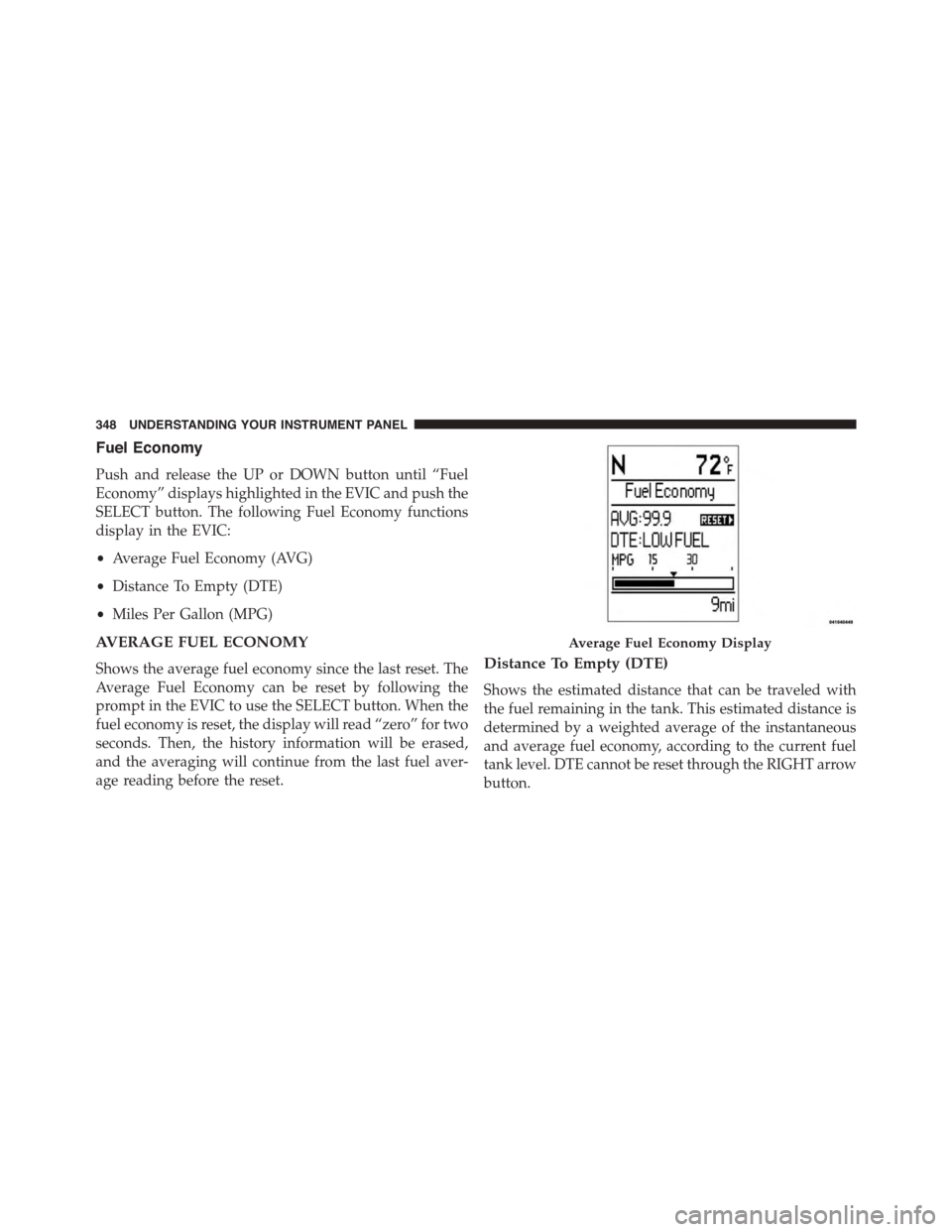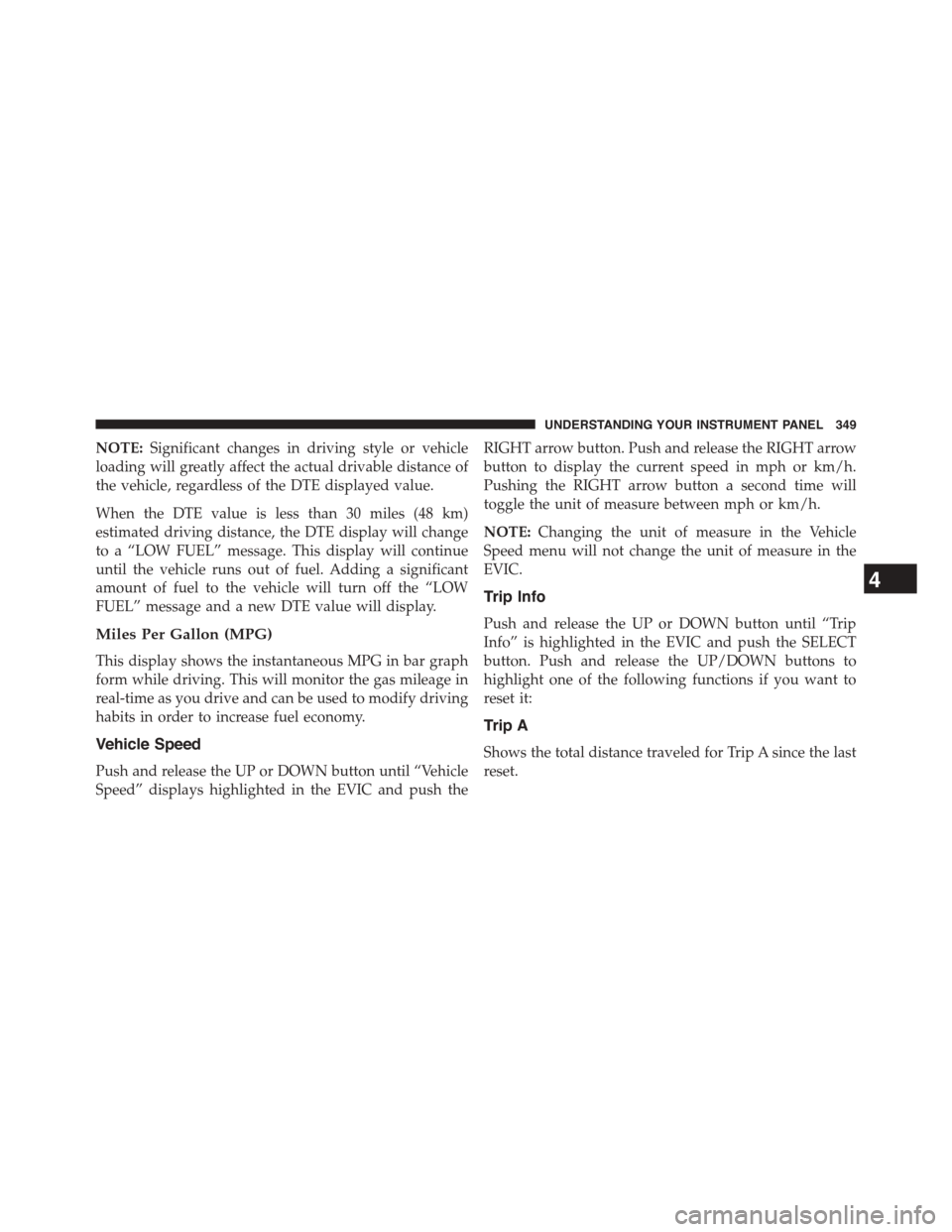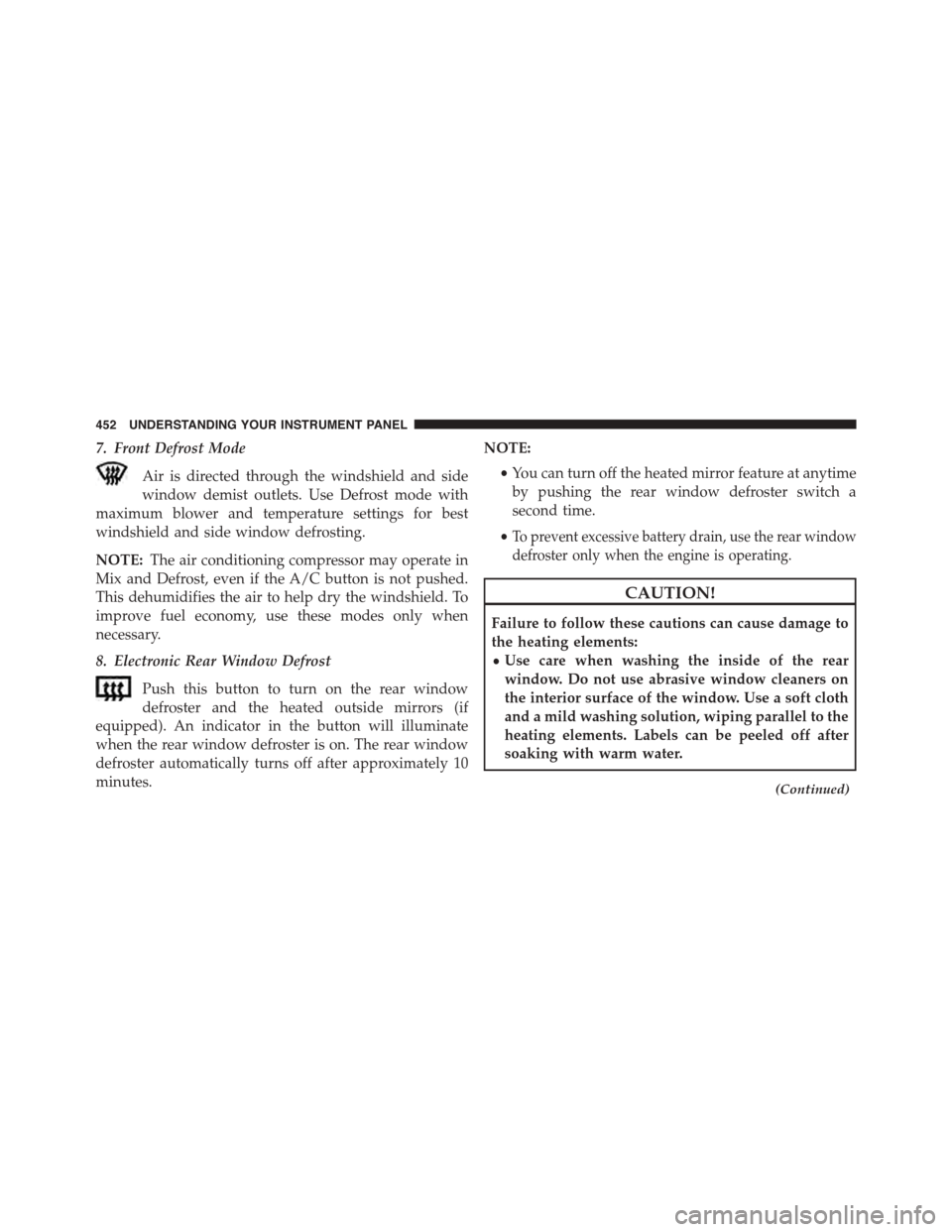Page 345 of 726

•Electronic Speed Control Ready
This light will turn on when the electronic
speed control is ready. For further information,
refer to “Electronic Speed Control” in “Under-
standing The Features Of Your Vehicle.”
•Electronic Speed Control SET
This light will turn on when the electronic
speed control is SET. For further information,
refer to “Electronic Speed Control” in “Under-
standing The Features Of Your Vehicle.”
EVIC Amber Telltale Lights
This area will show reconfigurable amber caution tell-
tales. These telltales include:
•Low Fuel Light
When the fuel level reaches approximately 3.0 gal
(11.0 L) this light will turn on, and remain on until
fuel is added.
•Loose Gascap Indicator
If the vehicle diagnostic system determines
that the fuel filler cap is loose, improperly
installed, or damaged, a loose gascap indicator
will display in the telltale display area. Tighten
the fuel filler cap properly.
A loose, improperly installed, or damaged fuel filler cap
may also turn on the Malfunction Indicator Light (MIL).
If the message continues to appear for more than three
days after tightening the gas cap, have the vehicle
serviced by an authorized service center immediately.
•Windshield Washer Fluid Low Indicator
This light will turn on to indicate the wind-
shield washer fluid is low.
4
UNDERSTANDING YOUR INSTRUMENT PANEL 343
Page 350 of 726

Fuel Economy
Push and release the UP or DOWN button until “Fuel
Economy” displays highlighted in the EVIC and push the
SELECT button. The following Fuel Economy functions
display in the EVIC:
•Average Fuel Economy (AVG)
•Distance To Empty (DTE)
•Miles Per Gallon (MPG)
AVERAGE FUEL ECONOMY
Shows the average fuel economy since the last reset. The
Average Fuel Economy can be reset by following the
prompt in the EVIC to use the SELECT button. When the
fuel economy is reset, the display will read “zero” for two
seconds. Then, the history information will be erased,
and the averaging will continue from the last fuel aver-
age reading before the reset.
Distance To Empty (DTE)
Shows the estimated distance that can be traveled with
the fuel remaining in the tank. This estimated distance is
determined by a weighted average of the instantaneous
and average fuel economy, according to the current fuel
tank level. DTE cannot be reset through the RIGHT arrow
button.
Average Fuel Economy Display
348 UNDERSTANDING YOUR INSTRUMENT PANEL
Page 351 of 726

NOTE:Significant changes in driving style or vehicle
loading will greatly affect the actual drivable distance of
the vehicle, regardless of the DTE displayed value.
When the DTE value is less than 30 miles (48 km)
estimated driving distance, the DTE display will change
to a “LOW FUEL” message. This display will continue
until the vehicle runs out of fuel. Adding a significant
amount of fuel to the vehicle will turn off the “LOW
FUEL” message and a new DTE value will display.
Miles Per Gallon (MPG)
This display shows the instantaneous MPG in bar graph
form while driving. This will monitor the gas mileage in
real-time as you drive and can be used to modify driving
habits in order to increase fuel economy.
Vehicle Speed
Push and release the UP or DOWN button until “Vehicle
Speed” displays highlighted in the EVIC and push the
RIGHT arrow button. Push and release the RIGHT arrow
button to display the current speed in mph or km/h.
Pushing the RIGHT arrow button a second time will
toggle the unit of measure between mph or km/h.
NOTE:Changing the unit of measure in the Vehicle
Speed menu will not change the unit of measure in the
EVIC.
Trip Info
Push and release the UP or DOWN button until “Trip
Info” is highlighted in the EVIC and push the SELECT
button. Push and release the UP/DOWN buttons to
highlight one of the following functions if you want to
reset it:
Trip A
Shows the total distance traveled for Trip A since the last
reset.
4
UNDERSTANDING YOUR INSTRUMENT PANEL 349
Page 454 of 726

7. Front Defrost Mode
Air is directed through the windshield and side
window demist outlets. Use Defrost mode with
maximum blower and temperature settings for best
windshield and side window defrosting.
NOTE:The air conditioning compressor may operate in
Mix and Defrost, even if the A/C button is not pushed.
This dehumidifies the air to help dry the windshield. To
improve fuel economy, use these modes only when
necessary.
8. Electronic Rear Window Defrost
Push this button to turn on the rear window
defroster and the heated outside mirrors (if
equipped). An indicator in the button will illuminate
when the rear window defroster is on. The rear window
defroster automatically turns off after approximately 10
minutes.
NOTE:
•You can turn off the heated mirror feature at anytime
by pushing the rear window defroster switch a
second time.
•To prevent excessive battery drain, use the rear window
defroster only when the engine is operating.
CAUTION!
Failure to follow these cautions can cause damage to
the heating elements:
•Use care when washing the inside of the rear
window. Do not use abrasive window cleaners on
the interior surface of the window. Use a soft cloth
and a mild washing solution, wiping parallel to the
heating elements. Labels can be peeled off after
soaking with warm water.
(Continued)
452 UNDERSTANDING YOUR INSTRUMENT PANEL
Page 475 of 726
STARTING AND OPERATING
CONTENTS
!STARTING PROCEDURES................477
▫Automatic Transmission................477
▫Keyless Enter-N-Go™ — If Equipped.......478
▫Normal Starting.......................479
▫Extreme Cold Weather (Below –20°F or−29°C). .481
▫If Engine Fails To Start.................481
▫After Starting........................483
!ENGINE BLOCK HEATER — IF EQUIPPED . . .483
!AUTOMATIC TRANSMISSION............484
▫Key Ignition Park Interlock...............486
▫Brake/Transmission Shift Interlock System . . .486
▫Fuel Economy (ECON) Mode.............486
▫Six-Speed Automatic Transmission.........487
!DRIVING ON SLIPPERY SURFACES.........496
▫Acceleration.........................496
▫Traction............................496
!DRIVING THROUGH WATER.............497
▫Flowing/Rising Water..................497
▫Shallow Standing Water.................497
!POWER STEERING.....................499
▫Power Steering Fluid Check..............500
5
Page 477 of 726

▫Limited-Use Spare — If Equipped.........535
▫Tire Spinning........................536
▫Tread Wear Indicators..................536
▫Life Of Tire.........................537
▫Replacement Tires.....................537
!TIRE CHAINS (TRACTION DEVICES).......539
!TIRE ROTATION RECOMMENDATIONS.....540
!TIRE PRESSURE MONITOR SYSTEM (TPMS) . .542
▫Base System.........................544
▫Premium System — If Equipped...........547
!FUEL REQUIREMENTS..................551
▫3.6L Engine..........................551
▫Reformulated Gasoline.................552
▫Gasoline/Oxygenate Blends..............552
▫E-85 Usage In Non-Flex Fuel Vehicles.......553
▫MMT In Gasoline.....................553
▫Materials Added To Fuel................554
▫Fuel System Cautions...................554
▫Carbon Monoxide Warnings.............555
!FLEXIBLE FUEL — IF EQUIPPED...........556
▫E-85 General Information...............556
▫Ethanol Fuel (E-85)....................557
▫Fuel Requirements....................557
▫Selection Of Engine Oil For Flexible Fuel Vehicles
(E-85) And Gasoline Vehicles.............558
▫Starting............................559
5
STARTING AND OPERATING 475
Page 478 of 726
▫Cruising Range.......................559
▫Replacement Parts....................559
▫Maintenance........................559
!ADDING FUEL........................560
▫Fuel Filler Cap (Gas Cap)...............560
▫Loose Fuel Filler Cap Message............561
!VEHICLE LOADING....................562
▫Vehicle Certification Label...............562
!TRAILER TOWING.....................565
▫Common Towing Definitions.............565
▫Towing Tips.........................576
!RECREATIONAL TOWING (BEHIND
MOTORHOME, ETC.)...................577
▫Towing This Vehicle Behind Another Vehicle . .577
▫Recreational Towing — All Models.........578
476 STARTING AND OPERATING
Page 483 of 726

2. Press the ENGINE START/STOP button a second time
to change the ignition switch to the RUN position,
3. Press the ENGINE START/STOP button a third time
to return the ignition switch to the OFF position.
Extreme Cold Weather (Below –20°F or−29°C)
To ensure reliable starting at these temperatures, use of
an externally powered electric engine block heater (avail-
able from your authorized dealer) is recommended.
If Engine Fails To Start
WARNING!
•Never pour fuel or other flammable liquid into the
throttle body air inlet opening in an attempt to start
the vehicle. This could result in flash fire causing
serious personal injury.
(Continued)
WARNING!(Continued)
•Do not attempt to push or tow your vehicle to get it
started. Vehicles equipped with an automatic trans-
mission cannot be started this way. Unburned fuel
could enter the catalytic converter and once the
engine has started, ignite and damage the converter
and vehicle.
•If the vehicle has a discharged battery, booster
cables may be used to obtain a start from a booster
battery or the battery in another vehicle. This type
of start can be dangerous if done improperly. Refer
to “Jump Starting” in “What To Do In Emergen-
cies” for further information.
5
STARTING AND OPERATING 481